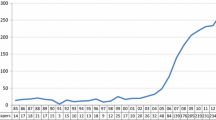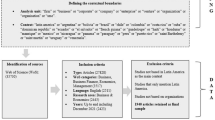Abstract
This study aims to map the content and structure of the knowledge base of research on intercultural relations as revealed in co-citation networks of 30 years of scholarly publications. Source records for extracting co-citation information are retrieved from Web of Science (1980–2010) through comprehensive keyword search and filtered by manual semantic coding. Exploratory network and content analysis is conducted (1) to discover the development of major research themes and the relations between them over time; (2) to locate representative core publications (the stars) that are highly co-cited with others and those (the bridges) connecting more between rather than within subfields or disciplines. Structural analysis of the co-citation networks identifies a core cluster that contains foundational knowledge of this domain. It is well connected to almost all the other clusters and covers a wide range of subject categories. The evolutionary path of research themes shows trends moving towards (e.g. psychology and business and economics) and away from (e.g. language education and communication) the core cluster over time. Based on the results, a structural framework of the knowledge domain of intercultural relations research is proposed to represent thematic relatedness between topical groups and their relations.









Similar content being viewed by others
Notes
A separate study by the same authors using the same dataset gives a more detailed report on the findings in this aspect and the results can be obtained by contacting the authors.
References
Bastian, M., Heymann, S., & Jacomy, M.G. (2009) An open source software for exploring and manipulating networks. In International AAAI Conference on Weblogs and Social Media.
Blondel, V. D., Guillaume, J.-L., Lambiotte, R., & Lefebvre, E. (2008). Fast unfolding of communities in large networks. Journal of Statistical Mechanics: Theory and Experiment, arXiv: 0803.0476.
Casmir, F. L., & Asuncion-Lande, N. (1990). Intercultural communication revisited: conceptualization, paradigm building, and methodological approaches. Communication Yearbook, 12, 278–309.
Harman, R. C., & Briggs, N. E. (1991). SIETAR survey: Perceived contributions of the social sciences to intercultural communication. International Journal of Intercultural Relations, 15(1), 19–28. doi:10.1016/0147-1767(91)90071-n.
Hart, W. B. (1999). Interdisciplinary influences in the study of intercultural relations: a citation analysis of the International Journal of Intercultural Relations. International Journal of Intercultural Relations, 23(4), 575–589.
Kim, Y. Y. (2000). Mapping the domain of intercultural communication: an overview. In W. B. Gudykunst (Ed.), Communication Yearbook (Vol. 24, pp. 139–156). Thousand Oaks, CA: Sage.
Kulich, S. J. (2003). Beyond language to culture’s interdisciplinary dimensions: toward a broader focus in intercultural communications. In Y. Wu & Q. Feng (Eds.), Foreign Language and Culture Studies (Vol. 3, pp. 848–869). Shanghai: Shanghai Foreign Language and Education Press.
Leeds-Hurwitz, W. L. (1990). Notes in the history of intercultural communication: the foreign service institute and the mandate for intercultural training. The Quarterly Journal of Speech, 76(3), 280–298.
Leydesdorff, L., & Vaughan, L. (2006). Co-occurrence matrices and their applications in information science: extending ACA to the Web environment. Journal of the American Society for Information Science and Technology, 57(12), 1616–1628.
Moya-Anegon, F., Vargas-Quesada, B., Herrero-Solana, V., Chinchilla-Rodriguez, Z., Corera-Alvarez, E., & Munoz-Fernandez, F. J. (2004). A new technique for building maps of large scientific domains based on the cocitation of classes and categories. Scientometrics, 61(1), 129–145.
Rogers, E. M., Hart, W. B., & Miike, Y. (2002). Edward T. Hall and the history of intercultural communication: the United States and Japan. Keio Communication Review, 24, 3–26.
Waltman, L., van Eck, N. J., & Noyons, E. C. M. (2010). A unified approach to mapping and clustering of bibliometric networks. Journal of Informetrics, 4(4), 629–635. doi:10.1016/j.joi.2010.07.002.
Ward, C., Bochner, S., & Furnham, A. (2001). The psychology of culture shock (2nd edn.). London: Routledge.
Acknowledgments
Thanks to Rich Gazan for providing support and guidance throughout the project and thanks to anonymous reviewers for comments.
Author information
Authors and Affiliations
Corresponding author
Rights and permissions
About this article
Cite this article
Chi, R., Young, J. The interdisciplinary structure of research on intercultural relations: a co-citation network analysis study. Scientometrics 96, 147–171 (2013). https://doi.org/10.1007/s11192-012-0894-3
Received:
Published:
Issue Date:
DOI: https://doi.org/10.1007/s11192-012-0894-3




